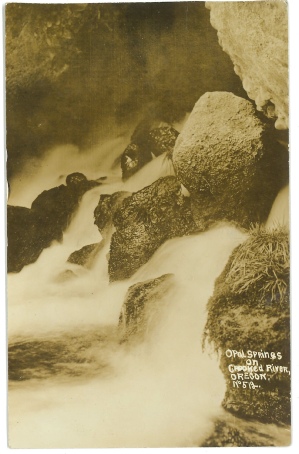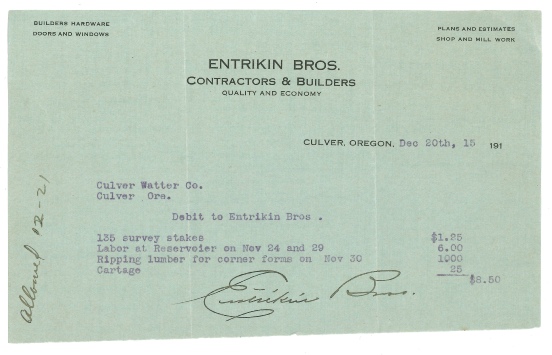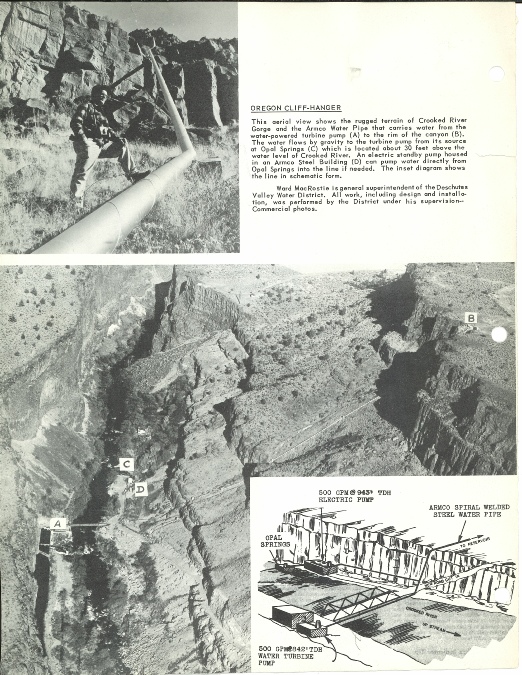History of Deschutes Valley Water District
Our History
Opal Springs was a large, very cold spring that came out of the canyon in such great force that it made a “boiling” effect. There was such a great amount of water that it made up a quarter of the Crooked River at this point. “Discovered” by pioneer Orla Hale, it was named Opal Springs because of the “opal-like” stones that seemed to boil and bubble out of the water.
The “opals” from Opal Springs were actually agates that were naturally polished by the water turbulence. The spring was one of the show places of Central Oregon and visitors never tired of dipping down into the spring with improvised, long-poled dippers, bringing up the jewel-like stones. Many people had them made into ring sets, and many homes had several jars of “opal” souvenirs after many trips to Opal Springs.
The water from Opal Springs was first utilized in 1898 by Mr. Windom, Jim McMeen, and G. Springer. With the help of several other stockmen and farmers in that community, they installed a water wheel and pump to raise the water to the first bench, a distance of about 500 feet. They initially used the fresh water for cattle.
About 1913, Mr. Miller had a homestead of 40 acres at the top of the canyon, running over the bluff on the Crooked River above Opal Springs. Miller put in what’s called a ‘water ram’ and ran a collector trough from several springs at the foot of the cliff, 40 to 50 feet above the river. These springs powered the water ram.
Drinking water was in scarce supply because much of the surface water was contaminated, causing Typhoid fever outbreaks. Many homesteaders purchased small tracts of land in the east foothills, where they dug wells to sell and haul water. In the Culver area, water was provided by a well 1,000 foot deep, producing only 12 gallons per minute.

Seeing a need for domestic water, Earl Thompson, an engineer, acquired a homestead on Opal Springs. He designed the Thompson Water Engine that would lift the pure, cold water 850 feet to the canyon rim. Pipes were laid starting at the canyon rim, thus the domestic water situation was overcome and water was first delivered through these pipes to Culver on August 22, 1916. To accommodate the 24 hour supervision and maintenance of the facility he hired Burr Larkin. In 1928, a house was built at the springs for the family, living there until 1956. The only access to this pumping plant and home was a one way dirt road to the first bench. From there you either walked down a trail or road a cable basket to the bottom.
The Larkin children, a son Chester and a daughter came out of the canyon daily to attend school in Culver. Unfortunately on one trip out of the canyon, their daughter fell to her death from the cable basket.
In later years, Earl Thompson went to work for General Motors Corporation. He designed the Synchromesh Transmission and a precision lathe. According to Chester Larkin, Thompson had claims on other springs on the Crooked River also.
The surrounding farmers formed “The Jefferson Water Company” in 1915. The Directors of the company were: W.H. Peck, William Barber, Fred Degner, William Boglie, Art Wright, and Mr. Cockeran. These men, with the help of other farmers, then built a 100,000 gallon reservoir. The reservoir was a cement square tub built party in the ground, with a wooden shingled roof. It was located at the top of the canyon on the Miller homestead. Four miles of 8 inch wood, wire-wrapped pipes were laid past the Limbaugh and Evans homesteads into Culver and the surrounding farms. This system provided basic drinking water and some garden water. Potatoes and grain were still dry land crops then. Erwin Horney recalled that 100 sacks per acre of dry land potatoes could be raised at the time.
The water system for Metolius was laid out by a railroad engineer, being provided by a railroad well 700 feet deep. Later, Metolius would be supplied by water from Opal Springs as well.
On February 11, 1919 the community formed a non-profit corporation – Deschutes Valley Water District, buying out the Jefferson Water Company. Thompson still owned Opal Springs, even though he had moved from the area, selling water to these companies under Opal Water Company. At the time Deschutes Valley Water District was formed, another reservoir was built east of Metolius, and east of what is now Highway 97.
In the early 1920’s, Thompson put in a water powered turbine pump at Opal Springs and another larger pipeline was put up the canyon. A 6” steel pipe was installed to the reservoir at the top of the canyon – providing all of Culver, Metolius and surrounding farms with metered water, at a cost of about $10.00 per month.

About this time a man by the name of Anderson proposed an irrigation project to bring irrigation water from the Deschutes River to the Madras, Culver and Metolius area. Anderson was Secretary of the project and $100,000 was raised by floating bonds, the money from mortgages against the farmers property.
Somehow, Mr. Anderson stole the money and disappeared. It would be 30 more years before irrigation would become a reality for the area.
Dick Hagman was in charge of the drinking water from Opal Springs, otherwise known as the “Water Master” – from 1926 to 1938. He repaired leaks, read meters, and checked reservoirs.
Erwin Horney, a young boy of 19, was a helper for Dick Hagman at times. Erwin’s job included pipe laying and repair. He remembers going on the meter route with Dick in the early 30s. There were about 32 meters at this time. Dick would read a meter, write the amount in a small receipt book, take the slip to the door and collect the water payment. Each water user had their own receipt book.
The books were kept in three apple boxes and there was no processing of the water bills or bookkeeping. The Water Board at this time consisted of Renver Jenkins, Burge Wright, Bill Barber, Vern Merchant, and Mr. Lockery.
In 1938, Francis Keeney became Water Master and he had the job until 1947, when Erwin Horney took over.
After the war (WW2) the irrigation project was finally complete and the land was divided and sold in 80 and 160 acre parcels. A homestead family was allowed to keep only 160 acres; the rest had to be sold at a set price. Many more homes were built and many more people wanted water. This sudden population growth required the District to install many new mainlines to distribute domestic water to the numerous new individual farms. During the same period, the area north of Madras (called the Agency Plains) formed a water district (the Plains Water District) to accomplish the same tasks in that area.
In 1948, the Plains Water District and Deschutes Valley Water District merged to form the approximate boundaries we have today. The conveyance of water over such a long distance (23.6 miles) presented many problems that required long District board meetings to solve. The District has been fortunate to have faithful and responsible Board members over the years. For many years, the District struggled with a meager budget to deliver to each service, with undersized and leaky mainlines.
In 1951, Ward MacRostie became the new Water Master. Ward was the engineering force behind building new reservoirs, replacing much of the old pipe, and setting up a bigger office to handle the demands.
Possibly the most important milestone in District history was the purchase of Opal Springs in 1958. Previously, the purchase of water and the poor condition of the pumps at Opal Springs had kept the District poor and without water at times. This purchase, along with modifications including a new pump house along with new discharge lines began a cycle that has been repeated over and over to this day. The process includes installing pumping capacity, discharge lines, storage, and then distribution lines. By the time a cycle is finished, new and improved facilities are required and the cycle begins anew.
As a side note: In 1963, the previously mentioned original homesteader of Opal Springs, Earl A. Thompson, was awarded (with citations to Ralph F. Beck, William L. Carnegie, Walter B. Herndon, Oliver K. Kelley and Maurice S. Rosenberger) The Elmer A. Sperry Award for Advancing the Art of Transportation for design and development of the first notably successful automatic automobile transmission.
Deschutes Valley Water District bought the pumping plant and equipment from Thompson in 1958 and began levying bonds to finance the District. An office was opened in Madras in 1948, with Mrs. Elizabeth Green becoming the first Secretary. That same year Deschutes Valley Water District merged with The Plains Water District and began supplying domestic water to farms on the North end of the irrigation project. Another larger metal reservoir was built east of Highway 97, replacing the original wooden one.
The old reservoir at the top of the canyon at Opal Springs was torn down and three metal reservoirs totaling 4-1/2 million gallons were erected between 1959 and 1982. By 1982 there were approximately 2000 water meters.

In 1964, a 1 million gallon steel reservoir was built, replacing that wooden reservoir. The building still stands, it was used by Jefferson TV, then Crestview Cable, and eventually TDS broadband, (there are tentative plans to remove it. (2020))
This reservoir would supply water for Metolius and farmers in that area as well as water for the railroad and City of Madras.
In 1973, a tragic accident at Opal Springs claimed the life of Ward MacRostie. He was operating a piece of heavy equipment that flipped over, killing him instantly. The District’s Board of Directors then appointed his son Robert to be the replacement General Manager, and Robert would continue as manager until his retirement in 2004.
In 1980, under the direction of Robert MacRostie, Deschutes Valley Water District began engineering studies for a hydro-electric facility above Opal Springs on the Crooked River.
In 1982, a 2.5 million gallon reservoir at Metolius was erected, and in 1986 a 1 million gallon reservoir on the Agency Plains.
Construction on the new hydro-electric facility was completed in March 1985. The power generated is sold to Pacific Power, a division of PacificCorp.
Power sales revenues from the new power plant were able to replace the need for property taxes once levied by the District.
CH2M Hill engineers and planners prepared the Federal Energy Regulatory Commission (FERC) license application and provided pre-design, design, and construction management services. The project included constructing a new powerhouse, raising an existing diversion dam 12 feet, and installing two 12.5 foot diameter corrugated metal conduits. Water is transmitted about 1500 feet from the dam to the powerhouse. The conduits were cement mortar lined to reduce friction losses.
The Powerhouse encloses a 10 foot diameter horizontal tube-type turbine with adjustable blades that drives a synchronous generator. The project’s maximum output is 6,000 kilowatts.
“NEWER” HISTORY
In 1999, discussions began about a new fish passage at Opal Springs to allow fish to get around the hydro dam. It took a lot of effort and a few years to accomplish this goal, and in November 2019 (20 years later!) construction was complete. For the full story, check out our Sept 2020 Newsletter.
Other construction projects in the last decade - we added another pipeline (24 inch) out of the canyon to make sure water demand is met. In 2012 a new storage reservoir (110K gallon) was constructed on the south flank of Round Butte, and in 2013 we added another 4 million gallon tank to our Main Tanks site on La Salle Lane. In 2020, a new river turbine pump was constructed. This river turbine allows us to use the power of the river to pump Opal Springs water out of the canyon even if there is an area power outage. This is also a cost savings to the district.
In August 2019, after 33 years with the district and 15 years as General Manager, Edson Pugh retired. New General Manager Joel Gehrett hit the ground running, moving the district forward with new paperless billing options, radio read meters and other new technologies.
Our commitment is to provide our customers with the freshest, best tasting drinking water into the future!
This history is compiled from old letters, news clippings and typed recollections from various local history buffs, and gathered over the years by water district staff. We hope you have enjoyed reading this, and if you have any stories or photos to add to our collection, we’d LOVE it! Just get in touch with our office at (541) 475-3849 or email us at info@dvwd.org.

Updated: September 15, 2022


